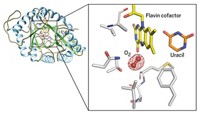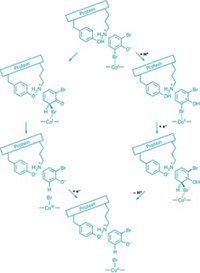Advertisement
Grab your lab coat. Let's get started
Welcome!
Welcome!
Create an account below to get 6 C&EN articles per month, receive newsletters and more - all free.
It seems this is your first time logging in online. Please enter the following information to continue.
As an ACS member you automatically get access to this site. All we need is few more details to create your reading experience.
Not you? Sign in with a different account.
Not you? Sign in with a different account.
ERROR 1
ERROR 1
ERROR 2
ERROR 2
ERROR 2
ERROR 2
ERROR 2
Password and Confirm password must match.
If you have an ACS member number, please enter it here so we can link this account to your membership. (optional)
ERROR 2
ACS values your privacy. By submitting your information, you are gaining access to C&EN and subscribing to our weekly newsletter. We use the information you provide to make your reading experience better, and we will never sell your data to third party members.
Synthesis
Reductive Dehalogenase Structures Solved
Structural Biology: Enzymes use vitamin B12 in unusual way, could be tools for bioremediation of halogenated pollutants
by Celia Henry Arnaud
October 27, 2014
| A version of this story appeared in
Volume 92, Issue 43

In recent weeks, two independent teams have reported long-sought X-ray crystal structures of two enzymes that remove halides from molecules with help from vitamin B-12. These so-called reductive dehalogenase enzymes enable some bacteria to breathe organohalides like other organisms breathe oxygen. A better understanding of these enzymes could lead to improved bioremediation of pollutants such as halogenated solvents.
In one study, structural biologist Holger Dobbek of Humboldt University of Berlin; microbiologist Gabriele Diekert of Friedrich Schiller University, in Jena, Germany; and coworkers report crystal structures of a reductive dehalogenase from the bacterium Sulfurospirillum multivorans alone and in the presence of its substrate trichloroethylene (Science 2014, DOI: 10.1126/science.1258118). In the other study, structural biologist David Leys and coworkers at the University of Manchester, in England, report a crystal structure and propose two possible catalytic mechanisms of a reductive dehalogenase from the bacterium Nitratireductor pacificus (Nature 2014, DOI: 10.1038/nature13901).
These structures represent the first detailed pictures of a specific class of B-12-dependent enzymes. Vitamin B-12, also known as cobalamin, is a cofactor that consists of cobalt coordinated to a tetrapyrrole ring. In other classes of B-12-dependent enzymes, the cobalt bonds to carbon on the substrate molecule. But in this class of enzymes, cobalt bonds with a halide atom on the substrate, the new structures reveal.

DoXbbek and coworkers were surprised by the size of the substrate-binding pocket. “We only realized once we had the substrate inside how tight this active site is,” Dobbek says. The trichloroethylene substrate fit in the space “like a hand in a glove.”
Leys and coworkers weren’t able to get a structure of the N. pacificus enzyme with its substrate. Instead, they performed electron paramagnetic resonance (EPR) experiments with the enzyme and 2,6-dibromophenol as a substrate to narrow down potential reaction mechanisms. They propose two possibilities that are consistent with their data.
In one mechanism, the reaction includes nucleophilic attack of Co(I) on the halogen and transient formation of a halogen-Co(III) species with subsequent reduction to Co(II). The other possibility involves cleavage of the carbon-halogen bond following formation of an aryl radical.
“Guided by structural and elegant EPR spectroscopic data, Leys and colleagues propose a provocative mechanism for cobalamin-dependent reductive dehalogenases, which have been notoriously difficult to study,” says Ruma V. Banerjee, a professor of biological chemistry at the University of Michigan Medical School who is an expert on B-12-dependent enzymes.
The researchers hope that organisms that use enzymes like the ones reported could be used in bioremediation. According to Leys, “Clearly, some of these bacteria have made it their business to survive entirely on mopping up whatever chlorinated entities are in the environment.”





Join the conversation
Contact the reporter
Submit a Letter to the Editor for publication
Engage with us on Twitter